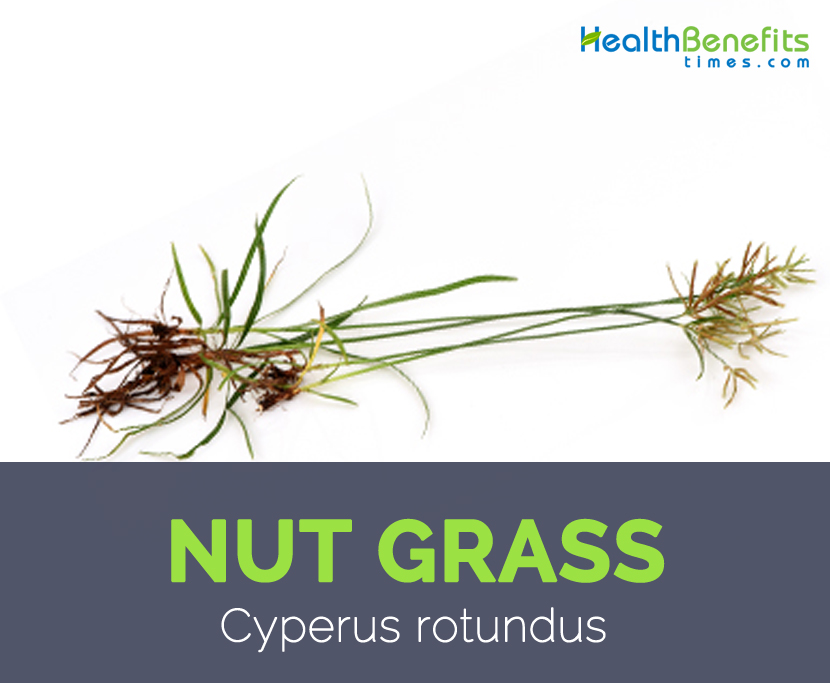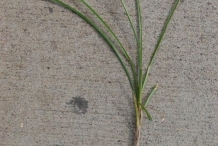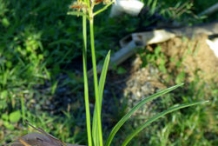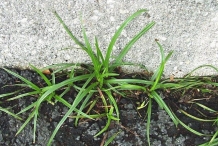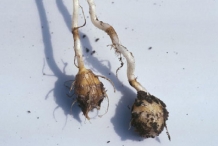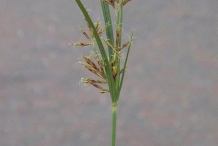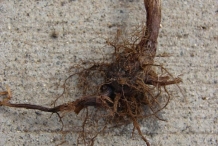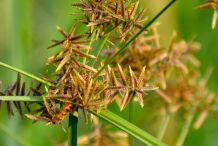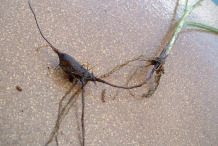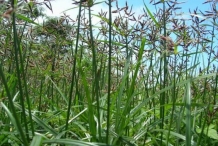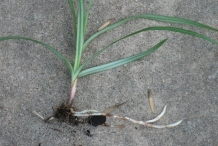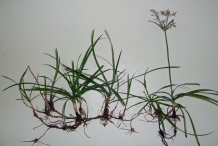| Nut Grass Quick Facts |
| Name: |
Nut Grass |
| Scientific Name: |
Cyperus rotundus |
| Origin |
Africa, southern and central parts of Europe, and southern Asia |
| Colors |
Dark reddish-brown |
| Shapes |
12 mm thick, and vary from 10-35 mm long |
| Taste |
Bitter |
| Health benefits |
Good for Skin care, Good for the digestive system, Control epileptic seizures or convulsions, Anti-diarrheal feature, Anti-inflammatory, Relieve Pain, Anti-spastic activity, Manage high blood pressure, Promotes weight loss, Reduce fever, Antiemetic action of nut grass, Lower cholesterol, Protects the liver, Lower blood sugar levels |
Nut grass(Cyperus rotundus) commonly known as Coco grass, java grass, red nut sedge and purple nut sedge is a perennial plant native to Africa, Southern and Central Europe, and Southern Asia. The grass is a member of the sedge family or the Cyperaceae family of plants so is a close relative of Cyperus esculentus, the tiger nut or chufa. Known to be one of the most invasive plants in the world, nut grass infests over fifty crops worldwide, and this feature has earned it the nickname “the world’s worst weed.” The tubers of the plant are bitter, but they have a nutritional value as food and have been eaten in famine-stricken areas. It has been used to cure a number of ailments in traditional medicine systems around the world. In Pakistan it is used for stomach problems, as a diuretic and stimulant as well as to improve the functioning of the nervous system. Additionally, the root is used as a perfume in India.
Plant
It is a colonial, herbaceous, perennial plant with fibrous roots that normally grows from 7-40 cm tall and reproduces extensively by rhizomes and tubers. The rhizomes are initially white and fleshy with scaly leaves which later become fibrous, wiry, and very dark brown with age. Rhizomes normally grow in any direction in the soil. Those growing upward and reaching the soil surface become enlarged forming a structure 2-25 mm in diameter variously called a “basal bulb, a tuberous bulb, or a corm” that produces shoots, roots, and other rhizomes. Rhizomes that grow downward or horizontally form individual tubers or chains of tubers. Individual tubers are dark reddish-brown when mature, about 12 mm thick, and vary from 10-35 mm long.
The dark green, shiny, three-ranked leaf blades arise from or near the base of the plant. They are narrow and grass-like ranging in size from 5-12 mm wide to 50 cm long and have a prominent channel in cross section. The leaf sheaths are tubular and membranous and attach to compact nodes at or near the base of the plant. The upright culms or stems are 10-50 cm tall, smooth, triangular in cross section, and support a much-branched inflorescence. Two to four leaf-like bracts subtend the inflorescence which is umbel-like consisting of 3-9 unequal length branches (sometimes referred to as rays) bearing spikes of 3-10 spikelets. The flowers are bisexual each with three stamens and a pistil bearing three stigmas. Fruit, although rarely produced, consists of a three-angled achene (nutlets).
History
C. rotundus is thought to have originated in Southeastern Asia and from there it was spread to the rest of the world during the last 2000 years. It has been used by ancient people in Africa (i.e., Nile Valley), China, and eastern Mediterranean as food, perfume, and medicine for centuries. This species first appeared in a Chinese medicine book around 500 AD (Negbi, 1992). The most likely method of introduction of this species into new habitat could be related to human activities. Seeds, tubers, and rhizomes may have been introduced as a contaminant in soil, mud, agricultural machinery, fodder, pastures, and crop seeds. In the United States, it is considered that it was unintentionally introduced during the 1800s. Since the 1880s, this species appears in collections made on islands in the West Indies.
Health benefits of Nut Grass
Root of the nut grass plant has been highly valued for many years in traditional Chinese medicine and Indian Ayurvedic medicine for its medicinal qualities. This plant has been used in the treatment and prevention of many ailments. Some of the medicinal uses of nut grass are described below:
1. Good for Skin care
Though the scientific evidence is limited, the nut grass plant has been considered to be beneficial for lightening the skin and for reducing the effects of aging. Nut grass helps to lighten the skin tone by preventing the formation of the skin pigment known as melanin. Extrapone, a formulation found in many skin whitening creams is made from the powdered extracts of nut grass roots. It is a natural way of skin lightening without any harmful or toxic side effects. Ayurvedic doctors make use of preparations of nut grass to treat numerous skin conditions like itching, fungus infestation, rashes and herpes.
2. Good for the digestive system
Rhizomes of nut grass have been used in traditional folk medicines in many Asian countries for the treatment of diarrhea, dysentery, intestinal parasites, indigestion, bowel disorders and other stomach problems. Chemical constituents present in this plant make it an effective remedy for combating indigestion. Apart from that nut grass consists of several enzymes and active compounds which help in stimulating various biochemical reactions that helps in promoting a better digestive system.
3. Control epileptic seizures or convulsions
Nut grass is quite beneficial for controlling epileptic seizures or convulsions. It was found that pretreatment with the ethanolic extract of nut grass offered considerable protection against convulsions (strychnine and leptazol-induced) in mice. Research suggests that the flavonoids found in the ethanol extract may be responsible for the anticonvulsant activity and this extract may be used to develop medicines for the treatment of epilepsy.
4. Anti-diarrheal feature
Research suggests that nut grass is quite helpful in preventing diarrhea in some people. For the study, diarrhea was induced in mice by giving castor oil. Researchers found that when mice were treated with nut grass, it caused inhibition of diarrhea by about 46 percent.
5. Anti-inflammatory
Research reveal that the alcoholic extract of nut grass possess anti-inflammatory activity which is effective against carrageenan (an indigestible polysaccharide extracted from red algae, which is commonly used in food as a thickening or stabilizing agent) induced oedema (water retention). It was also found to be effective against formaldehyde induced arthritis in albino rats. The triterpenoid that was obtained by chromatographic separation from petroleum ether extract of nut grass rhizomes also showed very high and powerful anti-inflammatory activity. The anti-inflammatory effects of nut grass make it a probable remedy for the treatment of inflammatory diseases.
6. Relieve Pain
According to studies, the essential oil and petroleum ether extract of nut grass possess powerful analgesic properties and therefore can be used to relieve pain.
7. Anti-spastic activity
Nut grass is found to have a relaxant action on smooth muscles. Researches on rabbits show that the ethanolic extract of this plant was capable of producing relaxation of the ileum and also produced spasmolytic effect against chemical induced contractions.
8. Manage high blood pressure
Studies showed that the alcoholic extract of nut grass caused slow and persistent lowering of blood pressure. It has been long used in traditional medicine as a remedy for managing high blood pressure.
9. Promotes weight loss
Nut grass has been found to prevent weight gain. In the study when some rats were given daily doses of nut grass extract for a period of 60 days. The results indicated that these rats showed a considerable reduction in weight without any change in food. So Nut grass is quite beneficial for preventing weight gain.
10. Reduce fever
Nut grass has been known to be beneficial for reducing fever and body temperature. In one study, the alcoholic extract of Cyperus rotundus was found to display significantly high antipyretic activity against fever or pyrexia in albino rats.
11. Antiemetic action of nut grass
Nut grass is found to be effective against vomiting and nausea as it shows antiemetic properties. The ethanolic extract of nut grass was found to prevent apomorphine induced vomiting in dogs.
12. Lower cholesterol
The effect of alcoholic extracts of nut grass on the serum lipid profile of rats was studied. Hyperlipidaemia was induced in these animals by feeding them a high fat diet. Treatment with the nut grass extracts showed significant reduction in the total cholesterol, LDL (bad cholesterol) and triglyceride levels. These results suggest that the bioactive compounds found in Cyperus rotundus have the ability to lower cholesterol.
13. Protects the liver
Studies conducted on rats indicates that the ethyl acetate extract given to rats with induced liver damage showed an important protective effect on the liver by lowering serum levels of total bilirubin and enzymes like glutamic oxaloacetic transaminase, glutamic pyruvic transaminase, and alkaline phosphatase.
14. Lower blood sugar levels
Extracts of nut grass have been found to cause significant lowering of blood sugar levels in diabetes induced rats. According to scientists, the anti-diabetic properties of this plant can be attributed to the presence of high levels of antioxidants in it.
Ayurvedic Benefits of Nut Grass
- Galactagogue: Peel off the fresh root of Nut Grass (Motha). Wrap the scrape around the breast. Or Make tuber paste of Nut Grass. Apply it over breast.
- Sore Breast: Prepare tuber decoction of Nut Grass. Drink 20 ml of it. Use it two times a day for 1 month.
- Bloody Diarrhea: Apply tuber paste of Nut Grass around your Nipples before feeding your baby. Or Consume 2 g tuber powder of Nut Grass with Honey. Take it thrice a day. This remedy is beneficial for Infants.
- Indigestion: Grind dried tuber of Nut Grass to make powder. Take 3 g of it with Honey twice a day.
- Immunity Booster: Grind tuber of Nut Grass to make a paste. Add 1 tsp of it in a glass of Milk. Boil. Drink once a day.
- Intestinal Diseases: Drink 10 ml tuber decoction daily.
- Anti-hydrotic: Apply tuber paste of Nut Grass over your body before taking bath.
- Hypo-cholesterolemic: Consume Nut Grass tuber either in powder or decoction form. It helps to control Cholesterol.
- Pancreatitis: Add 1/2 teaspoon of Nut Grass powder in 2 glass of water. Boil it until the water remains half. Add black pepper for taste. Drink it daily for a month to cure Pancreatitis.
- Dysentery: Take 20 gm. bulbous roots of Nut Grass and 5 gm. Ginger Peel them off. Crush them. Add half teaspoon honey. Take twice a day.
- Gastrointestinal Disorder: Take one teaspoon rhizomes of Nut Grass and a small piece of Ginger Grind them. Extract its juice. Mix one teaspoon Honey. Have it once a day.
- Skin Diseases: Take one part of Nut Grass tubers and ten parts of Green Gram. Grind them with water. Apply it on the affected part for 10 minutes. Wash with luke warm water.
- Body Odor: Take one part of Nut Grass tubers and ten parts of Green Gram. Grind them with water. Apply it on the body for 10 minutes. Wash with luke warm water.
- Baldness: Take tubers of Nut Grass. Dip in the water overnight. Grind it. Add in Sesame oil. Boil it on a low flame. Cool it down. Apply on scalp twice or thrice a week.
- Dandruff: Take tubers of Nut Grass. Dip in the water overnight. Grind it. Add it in 2 to 3 tablespoons of Sesame oil. Boil it on a low flame for 5 minutes. Let it cool. Strain well. Apply it on scalp and massage for 10 to 12 minutes. Leave it for 3 to 4 hours. Wash with shampoo.
- Fever: Take 50 g Nut Grass tuber, 50 g dried Ginger, 20 g Long Pepper and 30 g roots of Adhatoda Vasica. Make a decoction. Drink 5 ml of it thrice a day.
- Asthma: Grind dried roots of both Nut Grass and Beetle Killer in equal quantity. Make paste by adding water in it. Take 5 g paste with lukewarm water. Have it twice a day.
- Inflammation: Take Boerhavia Diffusa, Zingiber Officinale, and Cyperus Rotundus and prepare a paste. Apply the paste to the affected area 2 to 4 times a day for 5 days to reduce the inflammation.
- Stomach disorder: One or two crushed tubers boiled with about 200 ml cow milk are given in stomach disorder.
- Atisaar or Diarrhea: The dried root powder is given in dose of 5 grams with Butter milk 3-4 times a day.
- Jaundice, cold: The decoction of nut grass is beneficial.
- Improving health: The juice of nut grass is highly health promoting.
- Intestinal disorders: The roots are ground and taken with honey in dose of one teaspoon.
- Improving breast milk: The paste of fresh roots is applied on breasts.
- Sores, Wounds: The root paste is applied on affected places.
Nut Grass Facts
Nut grass is a perennial herb that is considered to be a harmful weed in many areas. However, Ayurvedic practitioners have valued the root of the nut grass plant for its medicinal qualities for many years. Its seeds are edible and can be used in extremis, but the rhizome is particularly valued for its oil and this is used in the perfume industry. The nut grass plant, or cyperus rotundus, has been touted as an aid for lightening the skin, reducing the effects of aging and controlling weight, although the research is limited. Extrapone is a specific formulation of nut grass that is used to treat skin conditions. Nut grass has been used to cure a number of ailments in traditional medicine systems around the world. In Pakistan it is used for stomach problems, as a diuretic and stimulant as well as to improve the functioning of the nervous system.
| Name |
Nut Grass |
| Scientific Name |
Cyperus rotundus |
| Native |
Africa, southern and central parts of Europe, and southern Asia |
| Common Names |
Coco grass, java grass, red nut sedge and purple nut sedge |
| Name in Other Languages |
Arabic: Sa’ed, zabl almaez (zibl almaeiz) (زبل المعز (زِبْل المَعِز), zabal almueiz (zibl almaeiz) (زبل المعيز (زِبْل المعيز)), saed (sied, saed) (سعد (سِعْد، سَعْد))، days (dis) (ديس (دِيس)), saed (sied, saed)(سعد (سِعْد، سَعْد))، sadar alhimar (sadralhmar)(صدر الحمار (صَدْرالحمار)), saed alhimar (saed alhumar) (سعد الحمار (سَعْد الحُمار)), saqit ( suqyt) (سقيط ( سُقيط)), samar (samar, sumar) (سمار (سَمار، سُمار)), majjssuh (majissh) (مجصه (مَجِصّه))
Assamese: Mutha, Somad Koophee
Bangladesh: Motha
Brazil: alho, alho-bravo, capim-alho, capim-dandá, junca, junca-aromática, tiririca, tiririca-comum, tiririca-vermelha, tres-quinas
Bengali: Mutha, Musta
Chinese: Suo cao, Xiang fu zi, Xiāng tóu cǎo( 香头草)
Cambodia: Smao kravanh chrouk.
Chile: Almendra de tierra, chufa, coquillo.
Colombia: Cortadera.
Cuba: Ajo Cimarron, basarillo, caramana, cebolleta, cebolleta de la provincial, cebollin, coquito, corojillo, corojito, juncia redonda, macaguita, yerba del rinon.
Dominican Republic: Afio, caramaná, coquille, junquillo de sabana, ronquillo, saqui-saco.
Egypt: Seid
English: Brown nut sedge, Coco-grass, Nut sedge, Nut-grass, Purple nut sedge, Red nut sedge, Java Grass, chaguan humatag, Galingale, Nut grass, nutgrass, Purple flat sedge, purple nutsedge, ground almond, purple nut-grass, red nut sedge, Water Grass
French: Herbe-à-oignon, Souchet à tubercules, Souchet rond, souchet d’Asie, souchet en forme d’olive
Finnish: Ruskosädekaisla,
Fijian: ivako, malanga, mot ha, soranakambani, soro ni kabani, soronakambani, vucesa, vuthesa
Gujarati: Moth, Nagarmoth
German: Rundes Zypergras, knolliges Zypergras, Apotheker-Cypergras; Asiatisches-Cypergras; Runde-Zyperwurzel
Greece: Kupere
Hawaiian: kili’o’opu, pakopako, mau‘u mokae
Hindi: Deela, gantola, korai, nagar motha.
Kannada: Konnari Gadde
Italian: Zigolo infestante, cipero orientale; cipero rotondo; stancia rotonda.
Indonesia: Teki
Iraq: Oyarslan
I-Kiribati: Te mumute, te mutemute
Iloko: balisanga
Japanese: Hamasuge.
Jamaica: Nut-grass
Korean: Hyangbuja, jakpangdong sani
Kenya: Moikut
Malayalam: Karimuttan, Kuzhimuthanga, Muthanga
Maori (Cook Islands): Matie ‘ōniāni, mauku ‘ōniāni, ‘ōniāni lau, ‘ōniāni rau, ‘ōniāni tita
Marathi: Moth, Nagarmoth, Motha, Bimbal
Marshallese: Tuteoneon, tutueoneon
Nauruan: Ibugibugi
Malaysia: Rumput haliya hitan
Mexico: Cebollin, pimientillo
Myanmar: Monhnyin-bin
Nepalese: Mothe
Newari: Kasu:
Portuguese: Junça, alho-bravo, capim-alho, capim-dandá, tiririca, tiririca-vermelha, capim-dandá, junca de conta
Punjabi: Mutha, Motha
Palauan: tamanengi
Pampangan: Mala-apulid, sur-sur
Peru: Coco, coquille, coquito.
Pakistan: Notha
Philippines: Balisanga, boto-botonis, mala-apulid, mutha, sur-sur
Puerto Rico: Coqui, coquillo
Samoan: Mumuta
Spanish: Castañuela, Coquito, Juncia, cipero, juncia real, almendra de tierra, cebollín, chufa, coco, coquillo, coquillo purpura, cortadera, cebolleta, chufila, cipero, contra yerba, corocilla, jonquillo, juncea, lengua de gallina, negrillo, paraquita, pasto bolita, totorilla
South Africa: Rooiuintjie, uintjie
Swedish: Nötag
Sri Lanka: Kalanthi
Suriname: Adroe
Siddha: oraikkizhangu
Thai: Ya haeo mu (Central Thailand), Ya khon mu.
Tamil: Korai, Korai-Kizhangu
Tagalog: Mutha
Taiwan: Hsiang-fu-tzu.
Tokelauan: Mumuta
Tongan: Pakopako
Tuvaluan: Mouku, muta
Unani: Naagarmothaa, Saad-e-Kufi
Bikol: Boto-botonis
Chamorro: Chaguan humatag
Turkey: Topalak
Telegu: Tungamustalu
Urdu: Sad Kufi |
| Plant Growth Habit |
Colonial, herbaceous, perennial |
| Growing Climate |
Cultivated fields, on roadsides, in neglected areas, and at the edges of woods, and it may cover the banks of irrigation canals and streams. |
| Soil |
Grows best in moist fertile soils. |
| Plant Size |
0.6 m (2ft) by 1 m (3ft 3in) |
| Root |
Fibrous roots |
| Rhizomes |
Initially white and fleshy with scaly leave and become fibrous, wiry, and very dark brown with age |
| Stem |
10-50 cm tall, smooth, triangular in cross section, and support a much-branched inflorescence |
| Leaf |
Dark green, shiny, three-ranked leaf blades ranging in size from 5-12 mm wide to 50 cm long and have a prominent channel in cross section. The leaf sheaths are tubular and membranous and attach to compact nodes at or near the base of the plant |
| Flower |
Bisexual, 2 to 8 inch in length, has three stamens and a pistil bearing three stigmas |
| Flowering Season |
Mar to July. |
| Fruit |
Although rarely produced, consists of a three-angled achene (nutlets), 1.5 mm long, dark brown or black. |
| Tuber Shape & Size |
12 mm thick, and vary from 10-35 mm long |
| Tuber Color |
Dark reddish-brown |
| Taste |
Bitter |
| Plant Parts Used |
Rhizomes |
| Health Benefits |
- Good for Skin care
- Good for the digestive system
- Control epileptic seizures or convulsions
- Anti-diarrheal feature
- Anti-inflammatory
- Relieve Pain
- Anti-spastic activity
- Manage high blood pressure
- Promotes weight loss
- Reduce fever
- Antiemetic action of nut grass
- Lower cholesterol
- Protects the liver
- Lower blood sugar levels
|
| Traditional Medicinal Uses |
- It relieves spasms and pain, acting mainly on the digestive system and uterus.
- The roots and tubers are analgesic, antibacterial, antispasmodic, antitussive, aromatic, astringent, carminative, diaphoretic, diuretic, emmenagogue, litholytic, sedative, skin, stimulant, stomachic, tonic and vermifuge.
- They are used internally in the treatment of digestive problems and menstrual complaints.
- They are commonly combined with black pepper in the treatment of stomachaches.
- An essential oil in the tubers has antibiotic activity and has been shown to arrest the growth of Micrococcus pyrogenes.
- The plant is used in the treatment of cervical cancer.
- The paste of nut grass is used in treating skin related ailments like scabies and eczema and helps in relieving itching.
- The paste is used in increasing the size of the breasts. It also purifies the breast milk, improves eyesight and helps in eye related ailments.
- The extract from the roots is instilled into eyes in conjunctivitis, to reduce the pain, redness and ocular discharges.
- Nut grass, when taken in powdered form, improves digestive system, removes worms from the gastro-intestinal tract, curbs infection and purifies blood.
- The powder is massaged to reduce the subcutaneous fat deposition in case of obese people.
- It normalizes the menstrual disturbances and breast discomfort and maintains normal body temperature.
- Nut grass proves useful in diseases like psychosis and epilepsy and mental diseases.
- The herb helps in healing wounds and uterine contraction and provides strength to the body.
- It is used as a diuretic to treat ulcers and as an emmenagogue and an ingredient in warm plasters.
- The herb proves to be a keen stimulant in appetite, digestion and digestion of ama.
- Nut grass is an effective remedy for distaste, vomiting, diarrhea, colitis and dyspepsia.
- It is considered the best herb for treating any type of fever.
- The root is often used for developing high memory.
- Nut grass is beneficial in treating cough and asthma, since it alleviates the kapha.
- The herb harmonizes liver, spleen, and pancreas. It helps in curing thirst, bronchitis, dysuria and poisonous affections.
|
| How to Eat |
- The dried roots can be ground into a powder and used as a cereal.
- It is very unpalatable when raw.
|
| Other Facts |
- The roots are harvested in the summer or winter and are dried for later use.
- The plant is rated 8th amongst 250 potential antifertility plants in China.
- The leaves are used in basketry and for weaving hats, matting etc.
- The aromatic root is used for perfumery in India.
- When dried and ground into a fine powder it is used like talcum powder.
- It is often used as an insect repellent for perfuming clothing.
|
| Precautions |
- It should be taken cautiously in constipation.
- It increases vata dosha.
|
References:
http://www.plantnames.unimelb.edu.au/Sorting/Cyperus.html
http://www.gbif.org/species/2714818/vernaculars
http://eol.org/pages/1121553/overview
https://www.itis.gov/servlet/SingleRpt/SingleRpt?search_topic=TSN&search_value=39900#null
http://davesgarden.com/guides/pf/go/31931/
http://www.gbif.org/species/2714818/synonyms
https://npgsweb.ars-grin.gov/gringlobal/taxonomydetail.aspx?id=316644
http://www.hear.org/pier/species/cyperus_rotundus.htm
http://www.pfaf.org/user/Plant.aspx?LatinName=Cyperus+rotundus
http://www.cabi.org/isc/datasheet/17506
http://www.floracatalana.net/cyperus-rotundus-l-
http://www.chineseherbshealing.com/nut-grass-xiang-fu/
https://www.bimbima.com/ayurveda/nutgrass-cyperus-rotundus-information-uses-and-side-effects/219/
http://www.planetayurveda.com/mustakpowder.htm
Comments
comments


